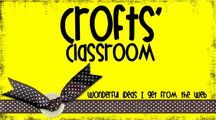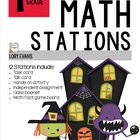
I had to become reacquainted with math 2 years ago when I returned to the regular classroom after years of reading intervention, and I discovered I loved it! Last summer I followed an online book study of Deb Diller's Math Work Stations and implemented math tubs in my classroom. The kids loved them and were always disappointed when we couldn't do them. This year I want to really implement guided math, so this summer's book study of Guided Math by Laney Sammons is perfect! Head over to Primary Inspired for all the details!
What worked this year:
- Math stations: Because I didn't have a lot of math materials, these took some time to create, but it was so worth it! I love putting together new stations! Two sources I rely on for quality activities are Donna at Math Coach's Corner and Lory Evans' Common Core workstations.
 |
| From Lory Evans |
- Organizing manipulatives: I put all of my manipulatives in labeled plastic boxes so they were easily accessible for lessons and for students to use during independent work.
- Calendar: I created a calendar routine for my Smart board. I tried to vary the activities a little bit each month and added a lot of number talk opportunities. If we ever missed calendar time, I heard about from the kids!
- Focus on numeracy: As primary teachers, we all know the importance of a print rich environment, but we've never really focused on numeracy. This year, I had a math wall and I displayed math anchor charts. It was a small step, but I wanted the kids to know we valued math as well as literacy.
- Math talk: Kids were regularly given a chance to explain their thinking to others. I need to do more, but it was a start!
Numeracy and math talk are so important! This past year we made and displayed many math anchor charts just like we do in language arts. I still want to create a permanent math word wall. I am also reading Laney's book Building Mathematical Comprehension and just hosted the chapter on vocabulary. (Check out my post here.) I definitely want to spend more time working with the language of math.
My goals:- More small group guided math. I'm still struggling with this a bit. I did a lot more work in small groups, but I know I need to do more!
- Utilize math journals: We used journal prompts regularly, but I want the kids to use the journals to record their thinking and learning during lessons and activities as well. Our district also uses Exemplars, a problem solving program, and following some of the procedures from this program really helped my students communicate their math thinking.
- Use individual math toolkits: I attended a workshop by Kim Sutton who advocates that the students build a supply of math tools to keep in their desks. I also want to use her number line. These kits were lifesavers! It saved a lot of time because I didn't have to pass out supplies like counters every time we wanted to use them, plus the students always had tools at their fingertips when working. This year we kept 2 color counters, a number line, a 100 chart and a part-part-whole mat in our kits all year. This year I am thinking about adding dice and coins. I also want to follow Kim's suggestion and add small chalkboards made from poster board and contact paper.
- Authentic assessments and record keeping. Whoa, still need lots of work in this area!,
- A new goal for this year: Utilize technology more. We use our smart board all the time, but I want to see my kids use technology tools for problem solving and to share their thinking.
Please come back and read my new post on chapter 2 on July 2.



Hi Carol! I love your post and can relate on so many points! I was also relieved that the schedule is flexible because I was worried about trying to fit it all in everyday. I need to do group work more (like a LOT more!) and have so far to go in the assessment and record keeping area. Baby steps, right? I am excited to see what changes this year will bring after reading this book!
ReplyDelete~Holly
Fourth Grade Flipper
I keep telling myself that baby steps are the way to go! I find I get myself in trouble when I bite off too much at once, and then I get frustrated and go back to how I've always done things! I really need to get busy working on some assessment ideas.
DeleteCarol
Oh man - I just Had to pin your anchor chart - ways to show your work! Fantastic! Thanks for sharing!
ReplyDeleteSara
We referred to that chart all year! I was inspired to create it by a post on Donna's site: http://mathcoachscorner.blogspot.com/ Of course, I can't find the exact post right now!
DeleteCarol
Instagram Takipçi Satın Al
ReplyDeleteToptan Telefon Kılıfı
Resimli Magnet
Silivri Çatı Ustası
Çerkezköy Çatı Ustası
538BG1
yurtdışı kargo
ReplyDeleteresimli magnet
instagram takipçi satın al
yurtdışı kargo
sms onay
dijital kartvizit
dijital kartvizit
https://nobetci-eczane.org/
VR4MY